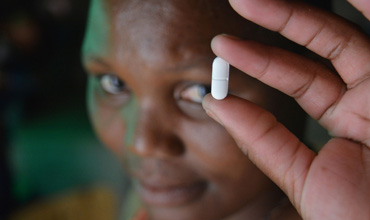Menstrual Changes among HIV Positive Women on Anti-Retroviral Treatment in Southwestern Nigeria

Abstract:
There are conflicting
reports regarding menstrual irregularities and HIV infection in women. Varying
degrees of menstrual abnormalities have been reported with prolonged ARV use,
and these have implications for drug adherence. The objective of this study was
to assess the effect of ARV drugs on menstrual pattern among HIV positive women
in South-western Nigeria. It was a descriptive cross-sectional survey among 238
HIV positive women on anti-retroviral therapy randomly selected after excluding
for co-morbidities. Research instrument was semi structured interviewer
administered questionnaires, and data was analyzed using the SPSS software.
Level of significance for statistic test was p ≤ 0.05
Mean age of respondents was
38.6±2.3 years and 205(86.1%) had commenced ART for a period of 1-5 years
mostly 1st line ART, 45(18.9%) have missed their ARVs at one time or the other
in the last 1year. Self reported adherence was good among 227(95.4%),
calculated adherence was above 95% among 185(77.7%) with a mean calculated
adherence of 93.0±3.6% and a median of 95.0%. About 167(70.2%) of respondents
reported a change in their menstrual pattern.
Different patterns of
menstrual changes reported were changes in number of days, interval between
menstruations and flow of menstrual blood, 52(73.2%) believed that use of ART
caused these menstrual changes, only 36(50.7%) reported these changes to the
doctor. Predictors of having menstrual disturbances include missing pills, poor
adherence and use of ARVs for period longer than 5years. ARVs were found to be
common causes of menstrual irregularities. Thus, clients‘ concerns should
always be addressed most especially issues that may compromise ARV adherence
References:
[1.] Abularach, Silvia, and Jean Anderson.
2005. ―Gynecologic Problems.‖ In A Guide to the Clinical Care of Women
with HIV, U.S. Department of Health and Human Services, Health Resources and
Services Administration, HIV/AIDS Bureau, 177–230.
[2.] Bach, Xuan Tran, Thanh Nguyen Long, Hoang
Nguyen Nga, Van Hoang Quynh, and Hwang Jongnam. 2013. ―Determinants of
Antiretroviral Treatment Adherence among HIV/AIDS Patients: A Multi Study.‖
Global Health Action 6.
[3.] Chirgwin, KD, J Feldman, O
Muneyyirci-Delale, S Landesman, and H Minkoff. 1996. ―Menstrual Function in
Human Immunodeficiency Virus-Infected Women without Acquired Immunodeficiency
Syndrome.‖ Journal of Acquired Immune Deficiency
Syndrome 12(5): 489–94.
[4.] Ellerbrock, TV, TC Wright, TJ Bush, P
Dole, K Brudney, and MA Chiasson. 1996. “Characteristics of Menstruation in
Women Infected with Human Immunodeficiency Virus.‖ Obstet Gynecol
87(6): 1030–34.
[5.] Harlow SD, Schuman P, Cohen, M, SE Ohmit,
S Cu-Uvin, X Lin, K Anastos, D Burns, R Greenblatt, H Minkoff, L Muderspach, A
Rompalo, D Warren, MA Young, and RS Klein. 2000. “Effect of HIV Infection on
Menstrual Cycle Length”.‖ Journal of Acquired Immune Deficiency
Syndrome 24(1): 68–75.
[6.] Hoytt, Mary Jo. 1998. Menstrual Symptoms
in HIV Positive Women.
[7.] Maclean, Deirdre. 2000. Menstrual Problems
and HIV. Canada.
[8.] New York State Department of Health AIDS
Institute. 2011. New York Menstrual Disorders in HIV-Infected Women.
[9.] Nielsen, H. 1999. ―Hypermenorrhea
Associated with Ritonavir.‖ Lancet 353: 811–12.
[10.]
Ogundahunsi,
O A, M O Ogundipe, N O Akinola, O O Soyinka, A O Odewabi, and Oyegunle V A.
2011. ―The Effect of HIV and Antiretroviral Therapy on Fertility Hormones in
Amenorrheic HIV-Positive Women.‖ African Scientist 11(3): 143–46.
[11.]
Okochi,
C. A., O. Oladepo, and A. J. Ajuwon. 2000. ―Knowledge about Aids and Sexual
Behaviors of Inmates of Agodi Prison in Ibadan, Nigeria.‖
International Quarterly of Community Health Education 19(4): 353–62.
[12.]
Okonko,
I O, P O Okerentuga, and Akinpelu A O. 2012. ―Prevalence of HIV among Attendees
of ARFH Centre in Ibadan , Southwestern Nigeria.‖ Middle-East
Journal of Scientific Research 11(1): 7–12.
[13.]
Olugbenga-Bello,
A I, O A Adeoye, and K G Osagbemi. 2013. ―Assessment of the Reproductive Health
Status of Adult Prison Inmates in Osun State , Nigeria.‖
International Journal of Reproductive Medicine: 1–9.
[14.]
Omoyeni,
Sunday T, Akanni I Akinyemi, and Adesegun Fatusi. 2012. ―Adolescents and
HIV-Related Behaviour in Nigeria : Does Knowledge of HIV/AIDS Promote
Protective Sexual Behaviour among Sexually Active Adolescents?‖
In Population Association of America Annual Meeting, California, 1–19.
[15.]
Paterson,
DL, S Swindells, J Mohr, M Brester, and EN Vergis. 2000. ―Adherence to Protease
Inhibitor Therapy and Outcomes in Patients with HIV Infection.‖
Annals of Internal Medicine 133(1): 21–30.
[16.]
Sethi,
Ajay K, David D Celentano, Stephen J Gange, Richard D Moore, and Joel E
Gallant. 2003. “Association between Adherence to Antiretroviral Therapy and
Human Immunodeficiency Virus Drug Resistance.” Clinical
Infectious Diseases 37: 1112–18.
[17.]
The
Well Project. 2011. HIV/AIDS -Menstrual Problems.
[18.]
Treat
Yourself Right. 2009. Menstrual Irregularities -Living with HIV.
[19.]
Wasti,
Sharada P., Padam Simkhada, Julian Randall, Jennifer V. Freeman, and Edwin van Teijlingen. 2012. ―Factors Influencing Adherence to Antiretroviral
Treatment in Nepal: A Mixed-Methods Study.‖ PLoS ONE 7(5).
[20.]
Wasti, SP, E Van
Teijlingen, P Simkhada, J Randall, and S Baxter. 2011. ―Factors Influencing
Adherence to Antiretroviral Treatment in Asian Developing Countries: A
Systematic Review.‖
Trop Med Int Health 17: 71–81.

